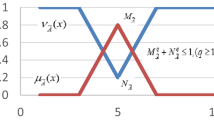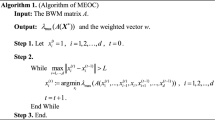Abstract
When evaluating the closeness between the decision matrix given by each expert and the overall decision matrix, we should pay more attention to the consistency of the ranking of candidates rather than the deviation degree of the scoring size. Therefore, in this paper, the modified cosine distance measure, instead of the Euclidean distance measure, is used to calculate the proximity between each expert decision matrix and the overall decision matrix. Furthermore, in order to receive more reasonable weights of experts, a new definition of coordinated expert weights in an optimization way is proposed. And then, the sequential quadratic programming (SQP) algorithm is used to derive the coordinated weights of experts, which is not affected by the selection of the initial value of expert weights and can objectively reflect the scoring level of each expert. Since different sorting methods would have inconsistent sorting results, a combined method based on SQP algorithm to derive the coordinated weights of different sorting methods is proposed to promote the ability of ranking the alternatives. Finally, numerical experiments are used to demonstrate the effectiveness of the SQP algorithm to derive coordinated expert weights with the modified cosine distance measure and the superiority of the combined method to rank alternatives.









Similar content being viewed by others
Data availability
Enquiries about data availability should be directed to the authors.
References
Abdel-Basset M, Manogaran G, Gamal A, Smarandache F (2019) A group decision making framework based on neutrosophic TOPSIS approach for smart medical device selection. J Med Syst 26(3):597–627
Akram M, Arshad M (2019) A novel trapezoidal bipolar fuzzy TOPSIS method for group decision-making. Group Decis Negot 28(3):565–584
Akram M, Garg H, Zahid K (2020) Extensions of ELECTRE-I and TOPSIS methods for group decision-making under complex Pythagorean fuzzy environment. Iran J Fuzzy Syst 17(5):147–164
Akram M, Kahraman C, Zahid K (2021a) Extension of TOPSIS model to the decision-making under complex spherical fuzzy information. Soft Comput 25(16):10771–10795
Akram M, Luqman A, Alcantud JCR (2021b) Risk evaluation in failure modes and effects analysis: hybrid TOPSIS and ELECTRE I solutions with Pythagorean fuzzy information. Neural Comput Appl 33(11):5675–5703
Atanassov K (1986) Intuitionistic fuzzy sets. Fuzzy Sets Syst 20(1):87–96
Biswas P, Pramanik S, Giri BC (2016) TOPSIS method for multi-attribute group decision-making under single-valued neutrosophic environment. Neural Comput Appl 27(3):727–737
Cuong BC, Kreinovich V (2013) Picture fuzzy sets-a new concept for computational intelligence problems, third world congress on information and communication technologies (WICT 2013). Hanoi 2013:1C6
Chen TY, Tsao CY (2008) The interval-valued fuzzy TOPSIS method and experimental analysis. Fuzzy Set Syst 159(11):1410–1428
Chen ZP, Yang W (2011) A new multiple attribute group decision making method in intuitionistic fuzzy setting. Appl Math Model 35:4424–4437
Deng JL (1989) Introduction to grey system theory. J Grey Syst 1(1):1–24
Gndogdu FK, Kahraman C (2019) Spherical fuzzy sets and spherical fuzzy TOPSIS method. J Intell Fuzzy Syst 36(1):337–352
Hwang CL, Lin MJ (1987) Group decision making under multiple criteria: methods and applications. Springer-Verlag, Berlin, Heidelberg
Joshi D, Kumar S (2016) Interval-valued intuitionistic hesitant fuzzy Choquet integral based TOPSIS method for multi-criteria group decision making. Eur J Oper Res 248(1):183–191
Ju Y, Wang A (2012) Emergency alternative evaluation under group decision makers: a method of incorporating DS/AHP with extended TOPSIS. Expert Syst Appl 39(1):1315–1323
Ju Y, Wang A (2013) Projection method for multiple criteria group decision making with incomplete weight information in linguistic setting. Appl Math Model 37(20):9031–9040
Kahraman C, Ruan D, Dogan I (2003) Fuzzy group decision-making for facility location selection. Inform Sci 157:135–153
Ma CF (2010) Optimization method and MATLAB program design. Science Press, Beijing
Ma YH, Zhou RX, Li ZG (2007) The method of determining the weights of decision-makers based on the maximizing deviation. J B Univ Chem Technol 34:177–180
Nocedal J, Wright ST (2000) Numerical optimization. Springer-Verlag, Berlin
Ramot D, Milo R, Friedman M, Kandel A (2002) Complex fuzzy sets. IEEE Trans Fuzzy Syst 10(2):171–186
Torra V (2010) Hesitant fuzzy sets. Int J Intell Syst 25(6):529–539
Tian ZP, Wang J, Wang JQ, Zhang HY (2017) Simplified neutrosophic linguistic multi-criteria group decision-making approach to green product development. Group Decis Negot 37(4):5531–5549
Ullah K, Mahmood T, Ali Z, Jan N (2020) On some distance measures of complex Pythagorean fuzzy sets and their applications in pattern recognition. Comp Intell Syst 6(1):15–27
Wei GW (2010) Extension of TOPSIS method for 2-tuple linguistic multiple attribute group decision making with incomplete weight information. Knowl Inf Syst 25(3):623–634
Wei GW (2010) A method for multiple attribute group decision making based on the ET-WG and ET-OWG operators with 2-tuple linguistic information. Expert Syst Appl 37:7895–7900
Xu Z, Hu H (2010) Projection models for intuitionistic fuzzy multiple attribute decision making. Int J Inf Tech Decis 9(2):267–280
Xu ZS (2007) Intuitionistic fuzzy aggregation operators. IEEE T Fuzzy Syst 15(6):1179–1187
Xu ZS (2007) Intuitionistic preference relations and their application in group decision making. Inform Sci 177:2363–2379
Yager RR (2013) Pythagorean membership grades in multi-criteria decision making. IEEE Trans Fuzzy Syst 22(4):958–965
Yang YX, He JQ (2021) A novel method based on fixed point iteration and improved TOPSIS method for multi-attribute group decision making. Int J Innov Comput I 17(1):5–29
Yuan YX, Sun WY (1997) Optimal theory and methods. Science Press, Beijing
Yue C (2019) Projection-based approach to group decision-making with hybrid information representations and application to software quality evaluation. Comput Ind Eng 132:98–113
Yue ZL (2011) Deriving decision maker’s weights based on distance measure for interval-valued intuitionistic fuzzy group decision making. Expert Syst Appl 38(9):11665–11670
Yue ZL (2012) Developing a straightforward approach for group decision making based on determining weights of decision makers. Appl Math Model 36(9):4106–4117
Yue ZL (2012) Approach to group decision making based on determining the weights of experts by using projection method. Appl Math Model 36(7):2900–2910
Yue ZL (2012) Application of the projection method to determine weights of decision makers for group decision making. Sci Iran 19(3):872–878
Yue ZL, Jia YY (2015) A group decision making model with hybrid intuitionistic fuzzy information. Comput Ind Eng 87:202–212
Acknowledgements
The authors would like to thank the editors and the anonymous reviewers for their insightful and constructive comments and suggestions of the paper. This work was supported partially by the Natural Science Foundation of Guangdong Province (2018A030307062).
Funding
This work was supported partially by the Natural Science Foundation of Guangdong Province (2018A030307062).
Author information
Authors and Affiliations
Corresponding author
Ethics declarations
Conflict of interest
The authors declare that we have no conflict of interest.
Human and animal rights
This article does not contain any studies with human participants or animals performed by any of the authors.
Informed consent
Informed consent was obtained from all individual participants included in the study.
Additional information
Publisher's Note
Springer Nature remains neutral with regard to jurisdictional claims in published maps and institutional affiliations.
Rights and permissions
Springer Nature or its licensor (e.g. a society or other partner) holds exclusive rights to this article under a publishing agreement with the author(s) or other rightsholder(s); author self-archiving of the accepted manuscript version of this article is solely governed by the terms of such publishing agreement and applicable law.
About this article
Cite this article
He, J., Yang, Y. Deriving coordinated experts’ weights based on sequential quadratic programming algorithm for multi-attribute group decision making. Soft Comput 27, 4865–4878 (2023). https://doi.org/10.1007/s00500-022-07663-y
Accepted:
Published:
Issue Date:
DOI: https://doi.org/10.1007/s00500-022-07663-y




